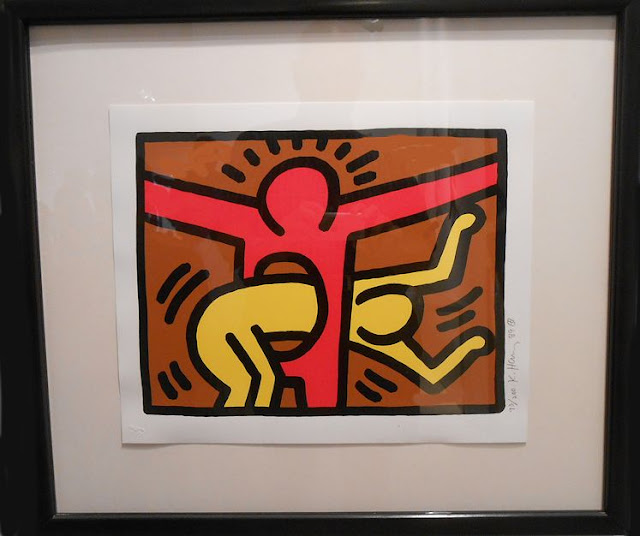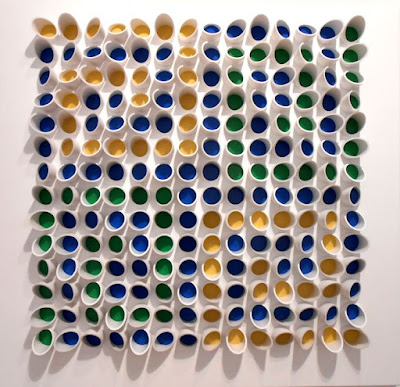Duane Hanson. "Gallery Guard." American. Fiberglass.
Duane Hanson's super-realistic gallery guard stood watch and puzzled many visitors.
Ms Laurence Jendell. "Wrapped Candy." France. Bronze.
The "Candy" has become Jendell's signature piece, in marble or bronze or plastic
and in many colors.
Manolo Valdes. "Regina con Sombrero." Spain. Wood
"tThe Queen with a Hat" is based originally on Matisse's
"Woman with Ostrich Feather Hat," a portrait of his wife.
"tThe Queen with a Hat" is based originally on Matisse's
"Woman with Ostrich Feather Hat," a portrait of his wife.
Carlos Cruz-Diez. "Op Art." Venezuela.
Cruz-Diez and Jesus Soto made Op Art almost the national art of Venezuela. Every
young artist must do some variation. Soto has died, but Cruz-Diez is still producing works
and is very prolific after 60 years.
Carlos Cruz-Diez. "Physio-Chromie." Venezuela.
This is Cruz-Diez' signature piece. It consist of many thin strips of wood glued to the surface and
each side of each slat is painted a different color. So as you walk by the sculpture, it changes
colors and form.
Soe Young Deoh. "The Hypocrit." Indonesia. Welded Bicycle Chains.
Soe Young has created many works using welded bicycle chains, which he reclaims from
junk yards, or welded chains of various sizes, which he also finds in the trash. His skill
is impressive. See detail below.
Soe Young Deoh. "The Hypocrite." Welded Bicycle Chains. Indonesia. Detail.
Head of "Hypocrite." Soe Young Deoh. Welded Bicycle Chains.
Ilhwa Kim. "Seed Portrait." South Korea. Folded Paper.
Kim here uses an ancient Chinese craft, Hanji, to fold mulberry paper into small
packets, then dye them and glue them to a surface in a pattern.
Detail of Ilhwa Kim. "Seed Universe." Folded Mulberry Paper. South Korea.
Shepard Fairey. "Obey / Peace." American.
Shepard is one of the leading street artists in America. He has several
splendid huge wall murals in Wynwood, as part of the festival. But he earns
a living with his gallery paintings, like this. This is one of his most famous
works. If we are told "Do Not Cross" or "Obey Flight Attendants," it
would be even better if we would "OBEY" these signs and keep peace.
works. If we are told "Do Not Cross" or "Obey Flight Attendants," it
would be even better if we would "OBEY" these signs and keep peace.
Banksy. "Soldiers Painting Peace Symbol.: England.
Banksy is the most famous of all Graffiti artists, British but still
anonymous. He first appeared during the "Aerosol Bomb" explosion
of graffiti art in Bristol, England in the 1980s. His identity is still unknown,
and he works between London and New York now. He still paints on
walls and abandoned buildings in England and the U.S. and his works
are eagerly photographed and disseminated by fans. Many are on the internet.
This work was first painted on a wall, and there are several different versions.
Banksy is the most famous of all Graffiti artists, British but still
anonymous. He first appeared during the "Aerosol Bomb" explosion
of graffiti art in Bristol, England in the 1980s. His identity is still unknown,
and he works between London and New York now. He still paints on
walls and abandoned buildings in England and the U.S. and his works
are eagerly photographed and disseminated by fans. Many are on the internet.
This work was first painted on a wall, and there are several different versions.
Keith Haring. "Pop Shop III." American. Graffiti Art. Litho.
Keith began his career by spray painting images like this on subway cars and walls in
New York. You have to move fast before the police or guards come running, so you
paint simple forms with strong outlines, so people can see it from a distance.
He called subway cars "Moving museums." Later, he did works like this for galleries.
Keith Haring. "Pop Shop IV." Litho. American.
William Barbosa. "Blue Arch." Aluminum. Colombia.
Barbosa was born in Colombia, but lives and works in Caracas,
Venezuela, at the present.
Venezuela, at the present.
William Barbosa. "Red Arch." Aluminim. Colombia/Venezuela.
Retna. "Secrets to Tell." American. 12 f.t x 6 ft.
Born Marquis Lewis in Los Angeles, Retna is recognized today primarily as a
graffiti artist. Several of the finest murals in Wynwood, including one seven-stories high,
are by Retna. His works, whether murals or on canvas, are a special calligraphy
which combines hieroglyphics, Arabic, Hebrew, and his own unique symbols.
This piece is about twelve feet long.
Born Marquis Lewis in Los Angeles, Retna is recognized today primarily as a
graffiti artist. Several of the finest murals in Wynwood, including one seven-stories high,
are by Retna. His works, whether murals or on canvas, are a special calligraphy
which combines hieroglyphics, Arabic, Hebrew, and his own unique symbols.
This piece is about twelve feet long.
Retna. From the "Provocateur" Series. American.
A Gallery devoted to Graffiti Artists.
On the left wall is Ryan McGinniss, straight ahead are four paintings by Robert Indiana,
and on the right wall are two works by Keith Haring, including "Barking Dog."

Robert Indiana. "Four Signs." Pop Art. American.
Indiana uses the form of a traffic sign or perhaps a manhole cover in the street. and then
adds words. The paintings are both visually striking patterns of colors, but the words
add a further dimension tot ehm.
add a further dimension tot ehm.
Joe Black. "Peace. 10,500 Soldiers." American. Tiny Plastic Soldiers
The beautiful orchid form is actually composed of 10,500 toy plastic soldiers.
Joe Black. "Peace." Close-up of toy soldiers.
Michael Halsband. "Andy Warhol and Jean-Michel Basquiat." Photo.
Warhol, the Pop artist, and Basquiat, the Graffiti artist, sometimes worked
together on artworks. They certainly admired each other, and neither
one was a boxer. So this posed photo is humorous in intent.
Nelson de la Nuez. "Chanel No. 5." Cuban-American.
Nelson was born in Cuba but brought to California as a child. He was
fascinated with American television, advertising, games, products.
He has made all of these subjects of his paintings. One of his favorite
products is Chanel No. 5. The dots suggest he knows Damien Hirst
and his famous dot paintings - a product in art.
Miguel Covarrubias. "Lovers on the Moon." Mexico.
Covarrubias' was a Mexican painter, caricaturist, illustrator, ehtnologist, and
art historian.
Covarrubias' was a Mexican painter, caricaturist, illustrator, ehtnologist, and
art historian.
Victor Manuel Garcia. "Sweethearts" Cuba 1948.
Victor Manuel Garcia Valdes was a Cuban painter and an early member of the
"Vanguardia" movement of artists who, beginning in the 1920s, combined
European concepts of Modern art with native Primitivism to create a
distinctly Cuban aesthetic.
Rene Portocarrero. "Lady with Hat." Cuba.
Portocarrero was one of Cuba's greatest artists. He was painter, sculptor,
ceramicist, stage designer, and book illustrator. For many years, he worked
in the village of Santiago de las Vegas alongside Wifredo Lam and
Amelia Pelaez, two of the other greatest artists in Cuban history.
Portocarrero was one of Cuba's greatest artists. He was painter, sculptor,
ceramicist, stage designer, and book illustrator. For many years, he worked
in the village of Santiago de las Vegas alongside Wifredo Lam and
Amelia Pelaez, two of the other greatest artists in Cuban history.
Rene Portocarrera. "Bouquet of Flowers." Cuba.
In terms of technique, Portocarrero was largely self-taught.
In terms of technique, Portocarrero was largely self-taught.
Reymond Romero. "Acromatia." Venezuela. Textiles and mixed media.
Romero is part of the strong Venezuelan tradition of Op Art.
Romero is part of the strong Venezuelan tradition of Op Art.
Pancho Luna. "Blue Books." Argentina. Acrylic.
When I first saw a photo of this before the show, I could not understand what it was.
When I saw it in the show, I was amazed. It consists of a series of blocks of clear
acrylic, which then have only the spine of a book glued to the back. When seen head-on,
they seem to be actual books. The entire gallery was filled with objects in which blue
was the dominant color.
Juvenal Ravelo. "Rejuvenation of Light 1." Venezuela Op Art.
Ravelo is one of the younger generation of Venzuelan Op Artists.
Ravelo is one of the younger generation of Venzuelan Op Artists.
Juvenal Ravelo. "Rejuvenation of Light 2." Venezuela.
Manuel Felguerez. "Andromeda." Mexican.
Felguerez is the greatest of living Mexican artists, working both as painter and sculptor.
He is now 92 years old. He has recently been constructing abstract wooden forms.
Manuel Felguerez. "Untitled." Mexican. Abstract Expressionism.
Felguerez paints on a large scale. This work is nine feet long and embellished with gold
foil. He has been influenced by the New York painters, but often refers back to
Mexican history or folklore.
Manuel Felguerez. "Untitled." Mexican. Abstract Expressionism.
Pablo Atchugarry. "Untitled." Uruguay/ White Marble.
The hard marble always look like soft fabric draping.
Pablo Athugarry. (Uruguay) "Two Sculptures." and Fernando de Szyslo (Peru)
"Ritual Ceremonies."
Fernando de Szyslo. "Ritual Ceremony." Peru.
De Szyslo is the greatest name in Peruvian art, and his paintings always deal with ancient
Pre-Columbian myths or religion or folk tales. This diptych is very large, 12 feet long.
Katrin Fridriks. "Silver Awareness." Iceland.
Her works explore speed, gravity, growth, and the interaction of man and nature.
It was interesting to see how artists even in Iceland have been influenced by
American Abstract Expressionism.
Her works explore speed, gravity, growth, and the interaction of man and nature.
It was interesting to see how artists even in Iceland have been influenced by
American Abstract Expressionism.
Mel Bochner. "Head Honcho." American. Embossed Handmade Paper.
Donald Sultan. "Black Poppies." Corten Steel. American.
Sultan has long painted very simplified flower forms on a very large scale; more
recently he has created 3D steel sculptures of these flowers.
Donald Sultan. "Yellow Poppies." American. Corten Steel.
__



















































































